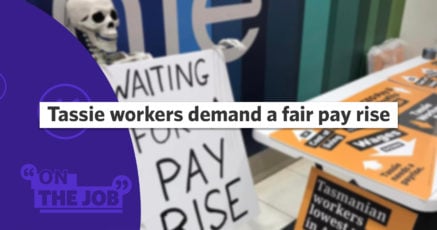Alice Leung is devoted to her job as a science teacher at a school in Sydney’s inner west.
“I love teaching. It’s the best job in the world and I don’t think I’ll be giving it up any time soon but there are a lot of other teachers I know who are saying – I can’t do this anymore.”
Leung and her colleagues in New South Wales are at a tipping point over staff shortages and poor wages that have continued for years and have pushed teachers to the limit.
And now, they’re pushing back.
Tuesday the 7th of December will see a state-wide teachers strike as the New South Wales Teachers Federation says enough is enough.
Angelo Gavrielatos is President of the Federation. He told “On the Job” that the strike action is a result of willful neglect of the teaching crisis by the state government.
“The decision to proceed with a 24-hour stoppage, the first one of its kind in 10 years, illustrates the depth of feeling. It shows the magnitude and the severity of the issues that lie ahead of us. The teacher shortage is too large. The underlying causes, namely uncompetitive salaries and unsustainable workflow are too great.”
“It makes it impossible for teachers and principals not to proceed with this action,” Gavrielatos said.
The teachers Union have been campaigning around these issues for years, warning the government that their ability to attract and retain the best teachers to the profession was being severely undermined by the punishing work regimes teachers face as well as the lack of real wage growth in the sector.
Gavrielatos is incensed that the government has acknowledged the depth of the crisis but steadfastly refuses to address it.
“These matters are known to the government. In early October, hundreds of pages of eternal government briefings were ventilated. Two things were clear. The size of the problem of the teacher shortage was outlined in one document that leads with the sentence – we will run out of teachers in five years.”
“Other documents described the cause being uncompetitive salaries and increasing expectations on teachers have made the profession less attractive.
“Another briefing document says that since the 1980s that teacher salaries have been declining relative to other professions making teaching a less attractive option for high achieving students.
“ The government knows all this.”
For Alice Leung and her colleagues, the strike action is necessary to drive home the message that the situation can no longer be tolerated by dedicated but overworked, underpaid teachers.
Combined with an employment model that sees huge numbers of teachers in inecure, short term contract jobs that see them bounce from school to school on a regular basis, teaching has become increasingly demanding and difficult for educators.
“It’s’s almost normal for people to start out in a casual, day to day relief teacher gig. They go above and beyond the get a noticed and get a more regular engagement.
“ You’ll be lucky to get a whole year at the same school. You’re basically chasing temporary engagements, term after term, year after year.”
Leung says that the demands of the job have only increased whilst the resourcing of schools and the wages that teachers are paid have stalled.
“The way to manage the workload is to take it home.”
“We teach a lot. The face-to-face teaching hours for primary school teachers hasn’t changed since the 1980’s and for high school teachers it hasn’t changed since the 1950’s.”
“A lot has changed in the last 70 years but the actual working conditions for teachers hasn’t kept up. You’re just teaching class after class, running from room to room from nine until three each school day.”
“In the end I have to take it home with me. Designing lessons, marking students work, doing administration. I work a full day then its two or three hours a night at home and up to six or eight hours a weekend of extra work just to meet my teaching commitments.”
“In the end it’s the kids that suffer because teachers get burnt out and leave. It’s an unsustainable model.”
Gavrielatos warns that unless the teacher crisis is health with now, there are huge problems on the horizon for education in the state.
“We’re facing a perfect storm. We’ve got an ageing teaching service. Number two, a massive increase in student enrolments and the biggest increase since the post war Baby Boom with 200,000 additional students in the system in the next 20 years.
“On top of that there is 30% reduction in people’s entering teacher education and that is compounded by the fact that the completion rates are only 50%. This means we’re barely graduating what we need now, let alone the fact that we’ll need to net another 11,000 teachers in 10 years time.”
“And all of this is known to the government.”
Support the Teachers Strike
An investment in our teachers is an investment in our students. Join our campaign and tell the NSW government that teachers deserve More Than Thanks!








SHARE:
Why teachers in NSW are striking today